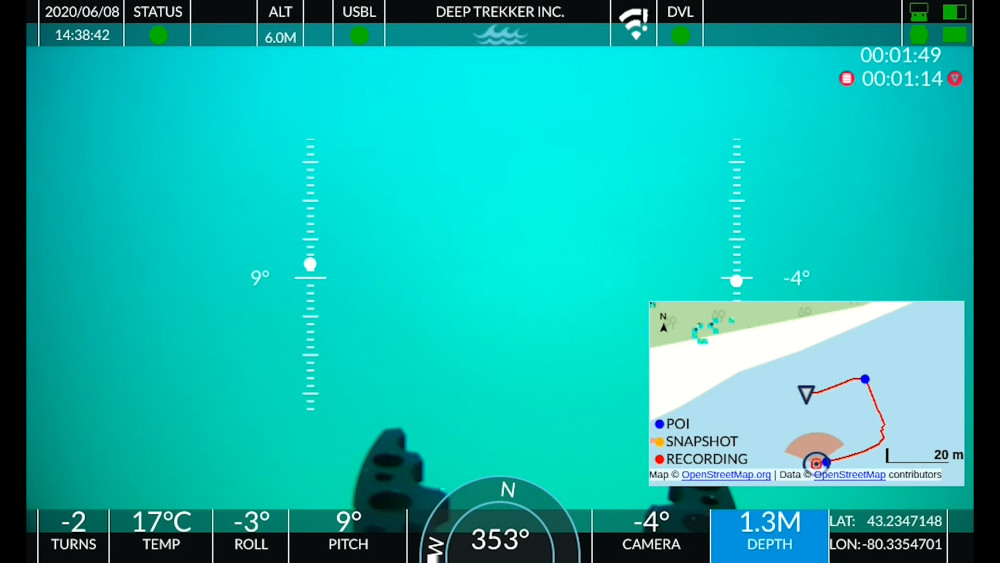Home › Forums › General › General Board › Sonar for use in Low vis and confined space ????
- This topic has 6 replies, 3 voices, and was last updated 7 years, 7 months ago by
Savante.
-
AuthorPosts
-
March 15, 2017 at 1:06 pm #7388
liddelljohn
ParticipantThe project i am currently working on has a requirement for navigating a small work class ROV in a very confined area with probable poor camera vis due to debris and stirred up silt ,, we currently have a standard Tritech sonar but are now looking into using something with more definition such as BLUE VIEW or Gemeni and similar units etc what we are concerned is targeting short range and problems with scatter in confied space area we need to profile a good image to operate safely and also identify targets ,, for retreival and inspection ,, the ROV will also be utilising a subsea sand silt vacuum so will likely stir up even more silt
hopefully the cameras will have good visiblity but we need to consider a decent alternative if the vis is very poor which is most likely situation,
I have used Blueview and other 2D 3D sonars and profilers in open water and structures with fabtastic results ,, but this is very different due to confied space im worried about reflective scatter etc
any suggestions or alternative ideas would be appreciated ,, we will rent and test before and purchase but time is money and also working in such an confined area will be very risky so accurate sensors are critical
regards Littlejohn
March 15, 2017 at 5:46 pm #36714Savante
ParticipantJohn, is this for work in an inshore tunnel or offshore?
If I keep my laser hat on one thing I can think of at the moment is actually just taking a few line lasers and project a swath infront of you. It might give slightly better illumination characteristics than flood lit illumination by keeping scattered light source in a thin plane but you may find it’s just clutching at straws if the water clarity is just too bad. We did this during some trenching operations and it was only a marginal improvement. Obviously not what you want if the situation is more dynamic or you’re floating around valves.
Now putting my offshore hat on – I would go for a 3D imaging sonar and mess with the gain ….
March 17, 2017 at 1:42 pm #36715rovnumpty
ParticipantHave a look at the Didson sonar camera.
Not sure who supplies them in the UK, but I was very impressed with it during inspection work in the gulf. Allowed us to navigate to specific points on different members in zero viz. Still had to wait for the viz to clear for the 3.4u, but at least we were bang in the right place when it did.
March 17, 2017 at 10:31 pm #36716liddelljohn
ParticipantIt will be offshore more than 1000m so good vis one way or the other critical ,,
I will have a look at the Didson too,,
March 18, 2017 at 8:57 am #36713Savante
ParticipantHi John,
I’ve put up an image from the underwater laser-aided trenching job below; really for illustrative purposes, (but also if someone looks for similar information later on down the line.) In any case, if your visibility is akin to that observed below then perhaps this may be relevant to you after all.
The image below shows a Lumeneye underwater laser profiler mounted on what I presume is the front of a subsea jet trenching unit. I suspect the laser may be pointing downwards towards the seabed beneath the trencher.
I didn’t have a technician out on this job unfortuntely; it was just our unit being used to test whether or not there would be a sufficient detection of the seabed for the pilots during landout onto the lay-product. The imaging would have been much better than achieved below if the operator had placed the video camera in close proximity and offset laterally to the underwater laser projector. (By way of example – the Lumeneye underwater laser shown here is only 30mm diameter so it’s been mounted quite a distance abaft the laser unit). I also suspect if the ROV flood lights had been reduced or directed elsewhere the laser swath would have been easier to observe too.
We have put together a real-time image processing system that to some extent enables the existing camera to improve the detection of the laser swath amidst the scattering, but in this market no one is really paying for it. The human eye does a pretty amazing job at picking up the laser swath amidst the scattering anyway. It’s not a game-changer, just a marginal improvement. The client liked it but they didn’t want to stump up for the LIDAR version of it.
Incidentally; if you are looking at this image on a laptop, you may find that the laser line here becomes easier to see if you move your head a few feet back and move your head around a bit too). I think there’s something to do with the way the brain receives low contrast signals like this from LED monitor screen. I promise this isn’t our attempt to have a few hundred ROV project managers in Aberdeen doing the reverse of the trainee sonar calibration procedure….. OR MAYBE IT IS !!!
Best Regards,
Grant
For more information; please visit our website at http://www.savante.co.uk
savante_subsea_laser_underwater_laser_trenching_underwater_laser_profiler_180.jpg Description: Herein an image of a Savante Lumeneye subsea laser projector profiler in use during jet trenching operations. This underwater laser profiler was mounted on the front of a jet-trenching unit and was intended to assist in imaging (detection of) the seabed.  March 19, 2017 at 7:26 pm #36717
March 19, 2017 at 7:26 pm #36717liddelljohn
Participantthanks savante ,, more food for thought ,, will you be at southampton show ???
March 20, 2017 at 9:53 am #36718Savante
Participantafraid not; it’s the start of our silly season now and I’m thin on the ground as it is. give me a call if you need.
-
AuthorPosts
- You must be logged in to reply to this topic.



